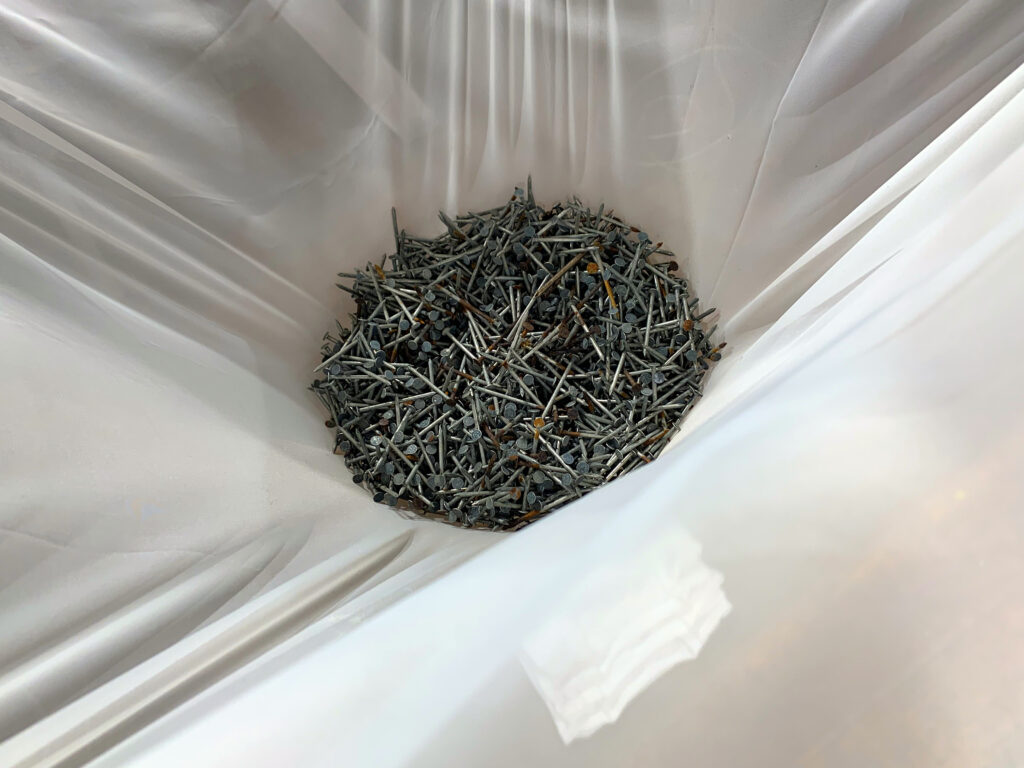
By Sherwin Rio, Exhibitions Fellow
I sat down with Katie Revilla and Andrew Ingersoll on a warm summer afternoon while each were taking lunch breaks from the nearby Asian Art Museum where they work. A stainless steel mixing bowl, two Trader Joe’s Salad Kits, and eco-friendly compostable forks and plates signalled the beginning of our lunch-time conversation. We passed the dish and also took turns sharing what was going on in our lives– relocating, finding work, friends in common, the conclusion and beginning of Masters programs. Spanning an hour, our conversation took on a rhythmic quality, perhaps a reflection of the kind of collaborative artwork the two artists across the table were planning.
For the month of July, the Frank-Ratchye Studio Artist Project Space is excited to present a new collaborative installation by Revilla and Ingersoll. The artists have put together an installation of expectation– ceremoniously merging time, gravity, and chemistry to an artwork that develops over the duration of its exhibition. Chiffon cloth and rusting nails will increasingly corrode and sag as water and vinegar rhythmically drip onto it throughout the course of the month. See Andrew Ingersoll & Katie Revilla: (Spider) Ceremony of Expectation at the 2nd Saturday opening on July 13th 7-10pm and read more about their work in our full interview below.
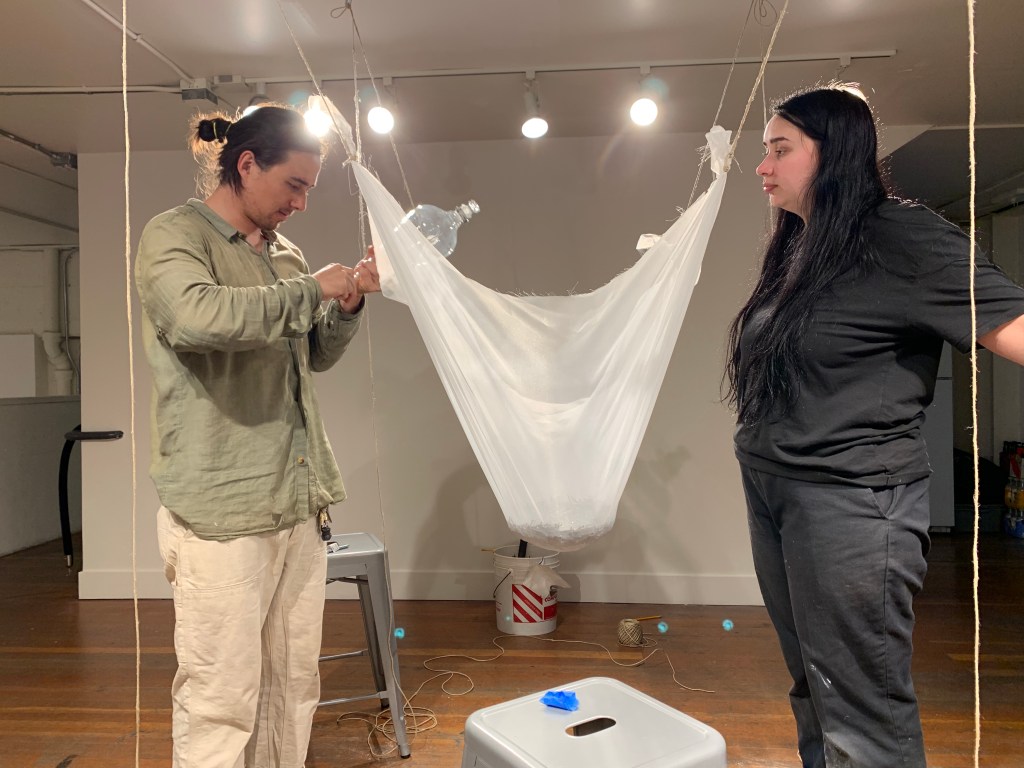
Sherwin Rio (Exhibitions Fellow): How did your collaboration start?
Katie Revilla (Artist): Drew and I have talked about collaborating for a long time…
Andrew Ingersoll (Artist): We shared a studio together in West Oakland so we’ve known each other a long time. We always humored the idea of doing a collaboration or me contributing armatures to her artwork. But this project started with spitballing ideas through iMessage and doodles with short descriptions and sending them to each other. The parts that we both liked would stick and carry on. The idea of rust dripping onto something and then permeating to a larger surface was a motif that carried on from a bunch of sculptural forms and turned into this percolating thing.
SR: You’re both artists who use elements of ritual and ceremony in your work, can you expand upon what that means for you and the viewer?
KR: I was baptized Catholic, and I remember some of my first aesthetic experiences being within a church. From the stained glass windows to tall arched ceilings; the architecture conveyed this sense of greatness. Paired with the chanting and reading, the whole occurrence felt to me like one performance. I think that was where my fascination to ritual and ceremony began, after I saw how the experience affected such a large mass of people into succumbing to power and control.
Along with that, I also witnessed how ritual gave individuals a sense of meaning, connectedness, and bond to a community. For my practice, I find ritual an important tool to create a sacred time and space. To bring myself and the viewer out of a certain mundanity and into intention within a performance or work to really heighten an experience is something that I explore throughout my work. On another layer, I’ve also had obsessive compulsive disorder since I was really young, and so you have your own personal set of rituals to ease your anxiety. If you are creating rituals in your head for most of your life subconsciously, now being aware and playing with that idea and the effects on the body and of other’s bodies really interests me.
AI: The root of that theme is in the basic function or purpose of the artwork in contrast to religious art, classical crafts, or ways of doing things and part of that is thinking about what gives an artwork power, or what gives something agency over an individual. In that same vein I’m objectifying the viewer in a certain sense– examining these systems of domestication that I see, and ceremonies or rituals are part of that. In our contemporary times examples of this can be seen as the ritual of youth soccer or the way we enter a gallery and see artwork. These are social activities that train us into a way of thinking. So much of the influential power to an artwork is its ability to affect someone’s psyche or the way people think. These ways of viewing the world parallel the sacred ones of the past. Like in a ceremony if you eat the bread and drink the wine, those sensory evocations are actualizing thought.
SR: Through this collaboration did you find a flow with how your practices overlap and/or diverge?
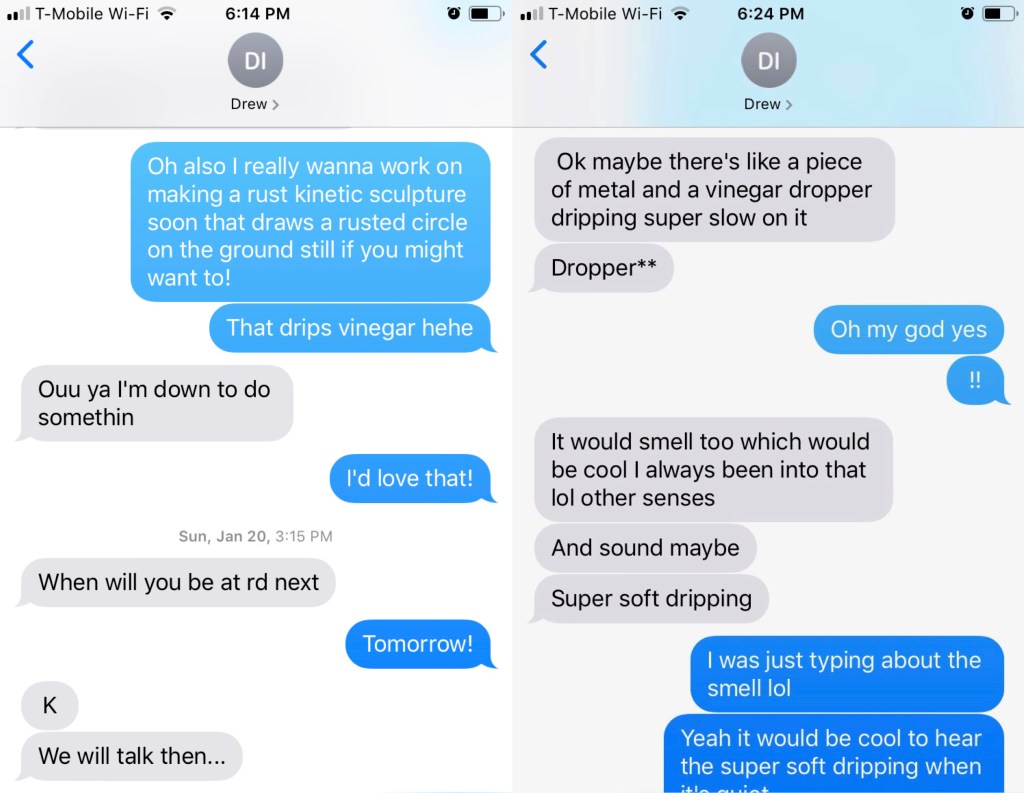
KR: Our practices overlap in the way we pull from our personal history and environments to make our work. I think we both have similar tastes when it comes to style, music, etc. that inform our practices, and therefore leads to similarities in our values and understanding as artists. We also both went to UC Berkeley for undergrad at the same time, and took the same classes, learned from the same teachers, and developed into our autonomy as artists around the same time, so it makes sense that we both have the same sort of principles and ethics when it comes to art making.
Drew approaches his work a lot differently than I do, with both a sort of critical inquiry and experimentation that I admire. He aligns his life to art making and always has since I’ve known him. I remember he got a meal plan during school so he wouldn’t have to ever go home, and instead go get food real quick at the dining hall on campus and then go right back in the studio. Even now, he moved to San Francisco so he could be as close as possible to his new studio. I have always really admired his tenacity and determination to keep making work. I don’t think he knows this, but he was one of the art superstars at school, and he inspired me to pursue being an artist when I first got to Berkeley.
AI: We overlap in friendship and differ in the way we approach our practice. Katie has very much the Cezanne approach: working one artwork in so many different variations. Whereas my approach is more of making a lot of different things working from idea to idea.
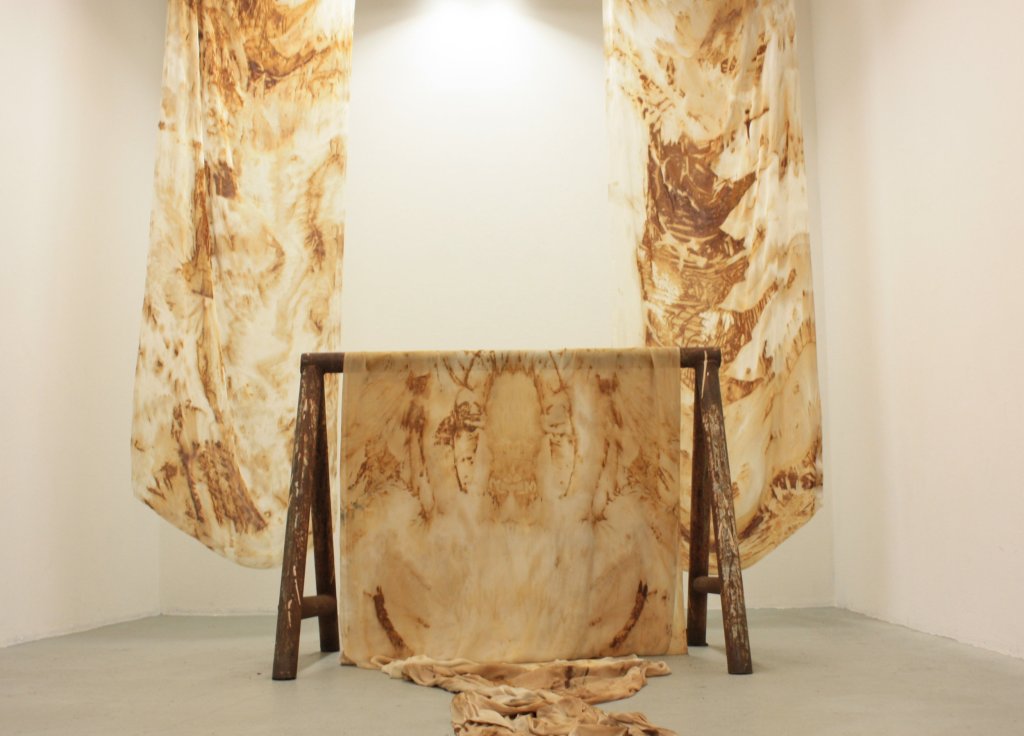
SR: You both seem to be drawn to unseen aspects like time, smell, history, gravity, immersion. Is there a reason you use such strategies?
KR: I’m really sensitive to the physicality of a space and how it makes me feel. Like when you walk into a Macy’s and it smells too perfumey and it almost makes you a little ill. The scent alone has the ability to completely change my comfort level within that space. I think we both thought, what if we could engage all of the senses in an installation? That way if a viewer is to walk into the space: the air, the light, the way they even walk has changed. It is a forced environment to make the audience realize they are stepping into our work, in a distinct area that is out of the rest of the building’s environment. Especially because of the location of our collaboration being on the second floor, and a place you have to walk to get to the kitchen, it can be so easily overlooked for a transitional space that is used to get somewhere else in the building. We wanted to shift the space in a way that almost gives you no choice but to confront our installation.
AI: I like the idea of magic, superstition, the power of faith, and the power of believing something. If you believe in something, in some ways that subjective truth is real and it has agency over you and your truth. But it’s also part of this greater existential question that could be related back to Plato’s theory of form where he says that the essence of something is even more real than the thing itself. Reaching or hinting towards that yearning for something larger than our physical world is something that’s essential to being human.
SR: I also get a sense of play from your works, is that something you’re consciously planning to work in to an artwork?
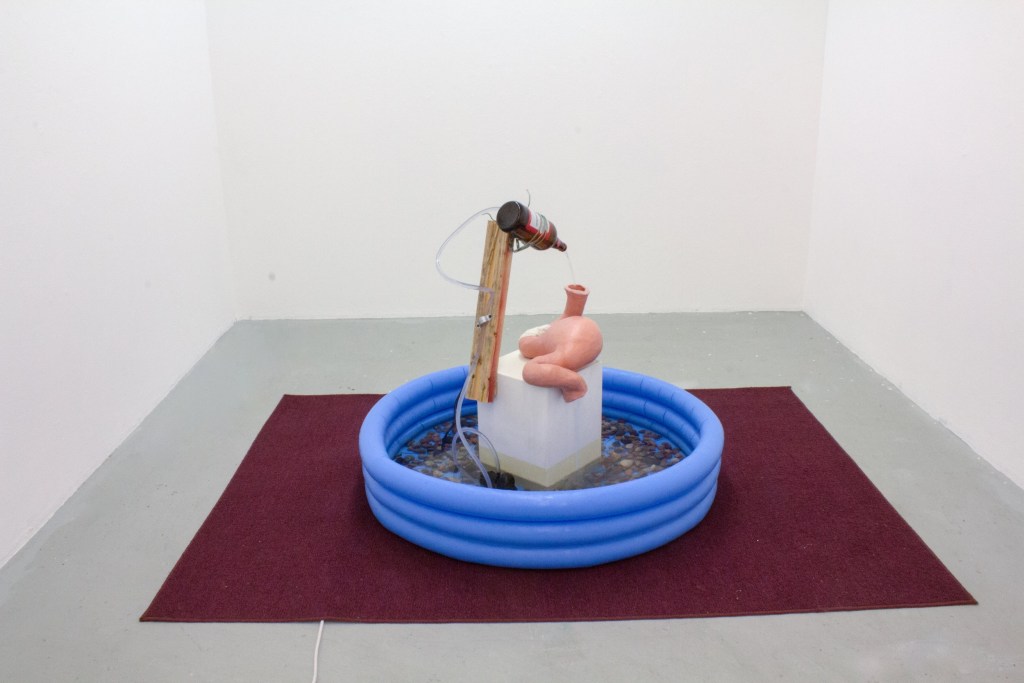
KR: To be honest, I think Drew is the one that brings that energy when we are working together. I have a tendency to take everything too seriously, and then when we start to talk about the work together we joke around and make all these crazy drawings, to the point where we are just experimenting. If there was no sense of play, I don’t think we would have collaborated to begin with because we would have taken it too far and over examined what our goals were. I think to make site specific work you have to sort of let go of worry, expectation, or result, and just feel out the space, which all goes back to our ability to play.
AI: I think that a lot of people take things too seriously and there’s not enough joy and pleasure in making things and in life. A lot of what I do is very serious work– research and labor– but I really do value having joy in the work because that joy is really what drives the passion. It’s not necessarily about trying to achieve an end goal. I want to make things that are enjoyable to my life and into the lives of others. I think that also speaks to the accessibility of a work. Even if my concepts are removed to XYZ degree from the work itself or if the individual doesn’t want to read into those concepts, playfulness is about wanting to speak to a wider audience and to be accessible– I don’t want someone to feel like they have to be a researcher to feel the essence of what I do. There are multiple levels and I want to make a tipping point for someone to jump into my work on a deeper more critical level.
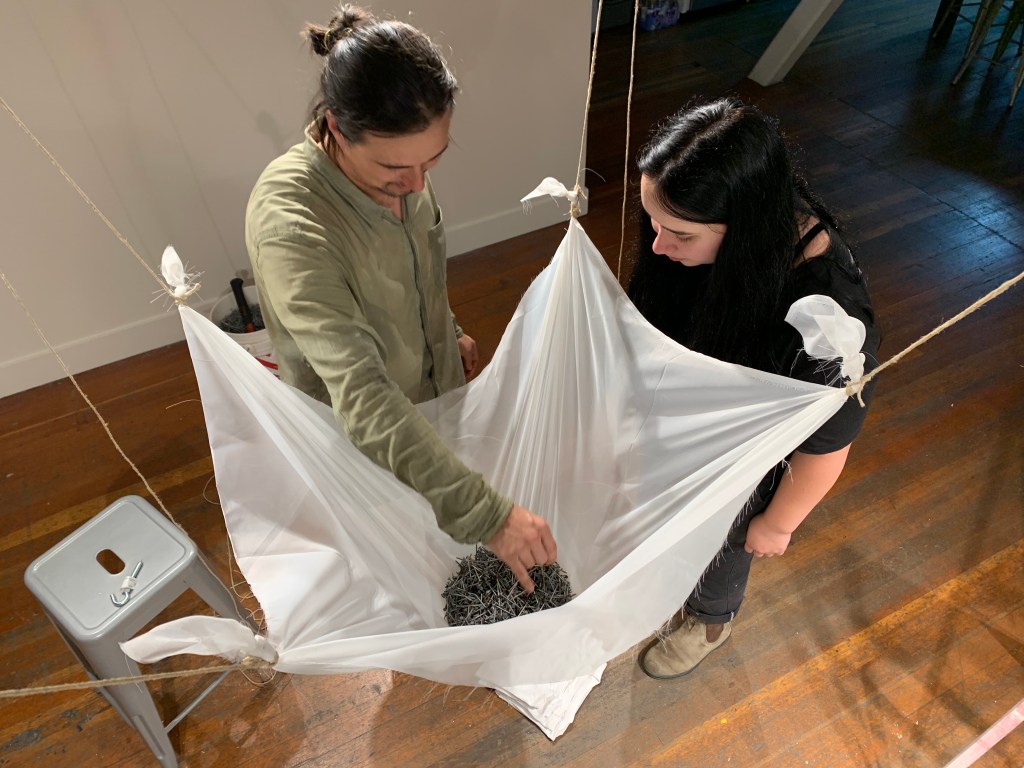
SR: Do you have any upcoming shows, projects, and/or events after July 12th (this is the latest day when the blog post will be published) you’d like to plug?
KR: I’m having a solo show at the Peninsula Museum of Art, with an Opening Reception on August 18, from 12-2pm. It will also be my last day in California before I leave!
AI: I’ve been really focusing a lot of my energy internally recently and I’ve been spending a lot of time on building out a studio space at Hunt Projects in Bayview around the corner from Guerrero Gallery. So give me a ring and come by for a studio visit!
